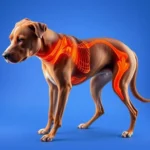
Lumps on dogs can be a source of concern for many pet owners. Recognizing and addressing these lumps in a timely manner is vital for the health and well-being of your furry friend. Pet owners often worry about what these lumps mean, how serious they are, and what steps should be taken next. This article aims to provide comprehensive information about lumps on dogs, including their identification, causes, diagnosis, treatment, and prevention.
Understanding Lumps on Dogs
Definition of Lumps
A lump is an abnormal mass or growth that can occur anywhere on a dog’s body. While the terms lumps, bumps, and nodules are often used interchangeably, they can refer to slightly different things. A lump typically denotes a sizable mass, while a bump may refer to a smaller or less defined protrusion. Nodules are usually small, solid masses that can be felt beneath the skin’s surface.
Common Types of Lumps
There are several types of lumps that can develop on dogs, including:
-
Lipomas: These are benign fatty tumors that are soft and movable. They are common in older dogs and usually require no treatment unless they interfere with the dog’s mobility or quality of life.
-
Sebaceous Cysts: These are small, benign lumps that form when sebaceous glands become blocked. They can become inflamed or infected, requiring veterinary intervention.
-
Malignant Tumors: Tumors such as mast cell tumors can be cancerous and require prompt diagnosis and treatment. Early detection is crucial for better outcomes.
-
Abscesses: These are localized collections of pus that can occur due to infections. They often feel warm to the touch and may be painful for the dog.
-
Skin Tags: These are benign growths that appear as small, hanging pieces of skin. They are generally harmless and don’t require treatment unless they become irritated or infected.
Causes of Lumps on Dogs
Genetic Factors
Certain dog breeds are predisposed to developing specific types of lumps. For example, breeds like Labrador Retrievers and Doberman Pinschers are more likely to develop lipomas, while Boxers are at higher risk for mast cell tumors. Understanding your dog’s breed can help you be more vigilant in monitoring for lumps.
Environmental Factors
Exposure to toxins or allergens can contribute to the development of lumps. Pollutants, chemicals, and certain materials can irritate the skin or lead to allergic reactions, resulting in lumps or bumps. Additionally, a poor diet lacking essential nutrients may weaken the immune system, making dogs more susceptible to developing abnormal growths.
Age-Related Factors
Age plays a significant role in the likelihood of developing lumps. Older dogs are more prone to developing benign and malignant tumors as their cells undergo changes over time. Regular check-ups become increasingly important as dogs age to catch any potential issues early.
Other Contributing Factors
Hormonal changes, infections, and inflammation can also lead to the formation of lumps. Hormonal imbalances, especially in unspayed females, can lead to various skin issues. Infections may cause localized swelling, while ongoing inflammation can result in the formation of cysts or other growths.
Identifying Lumps on Dogs
How to Examine Your Dog
Performing regular self-examinations on your dog is crucial for early detection of lumps. Here’s a step-by-step guide:
- Choose a Comfortable Setting: Find a quiet space where your dog feels relaxed.
- Use Your Hands: Gently run your hands over your dog’s body, paying attention to any unusual areas.
- Check Common Areas: Focus on areas such as the neck, underarms, belly, and legs, where lumps are often found.
- Observe Your Dog’s Behavior: Take note of any signs of discomfort when touching specific areas.
Key Characteristics to Look For
When you find a lump, consider the following characteristics:
- Size: Is the lump small (less than 1 cm) or larger?
- Shape: Is it round, oval, or irregular?
- Texture: Is it hard, soft, or rubbery?
- Mobility: Can it be moved easily under the skin, or is it fixed in place?
- Color and Temperature: Is the skin around the lump discolored or warmer than the surrounding areas?
When to Seek Veterinary Help
You should consult your veterinarian if you notice any of the following signs:
- The lump is rapidly growing.
- The lump feels painful or is causing your dog distress.
- There are changes in your dog’s behavior, such as lethargy or loss of appetite.
- The lump is accompanied by other symptoms, such as fever or swelling.
Diagnosis of Lumps on Dogs
Veterinary Examination
During a veterinary visit, the vet will perform a thorough examination of your dog. Expect them to ask questions about the lump, such as when you first noticed it, any changes in size or behavior, and your pet’s medical history.
Diagnostic Tests
To determine the nature of the lump, your veterinarian may recommend various diagnostic tests:
-
Fine Needle Aspiration (FNA) and Cytology: A thin needle is used to extract cells from the lump for examination under a microscope. This is a minimally invasive procedure that can often provide quick results.
-
Biopsy Procedures: If further analysis is required, a biopsy may be performed, which involves removing a portion of the lump for laboratory testing.
-
Imaging Tests: X-rays or ultrasounds may be used to assess if the lump is affecting internal structures or if there are additional masses.
Interpreting Results
The results of these tests can indicate whether the lump is benign or malignant. Understanding these outcomes is essential for determining the appropriate next steps. Follow-up consultations with your vet are crucial for discussing treatment options.
Treatment Options for Lumps on Dogs
Surgical Options
If the lump is determined to be cancerous or is causing discomfort, surgery may be recommended. The process typically involves:
- Anesthesia: Your dog will be placed under anesthesia to ensure comfort during the procedure.
- Excision of the Lump: The veterinarian will remove the lump and surrounding tissue as necessary.
- Recovery: Post-operative care will be required to ensure proper healing.
Medical Treatments
In some cases, lumps may not require surgery. Instead, treatment options can include:
- Medications: Anti-inflammatory drugs or antibiotics may be prescribed for infections or inflammation.
- Chemotherapy: If a malignant tumor is diagnosed, chemotherapy may be recommended to target cancer cells.
Home Care and Management
After surgery or treatment, monitoring your dog’s recovery is essential. Follow your vet’s instructions for post-operative care, which may include keeping the surgical site clean and monitoring for any signs of infection or complications.
Alternative Therapies
Some pet owners explore holistic approaches to manage lumps on dogs. While alternative therapies such as acupuncture or herbal treatments may be beneficial for overall health, they should not replace conventional veterinary care. Always consult your veterinarian before starting any alternative treatment.
Prevention of Lumps on Dogs
Regular Vet Check-ups
Routine veterinary visits are crucial for early detection and prevention of lumps. Regular check-ups enable your veterinarian to monitor your dog’s health and catch potential issues before they escalate.
Healthy Lifestyle Choices
A balanced diet rich in essential nutrients can help prevent the development of lumps. Ensure your dog receives:
- High-quality proteins.
- Omega fatty acids for skin health.
- Antioxidants to support the immune system.
Additionally, regular exercise is vital for maintaining a healthy weight and reducing the risk of fatty tumors like lipomas.
Environmental Awareness
Being aware of your dog’s environment can help minimize exposure to potential irritants. Consider the following:
- Limit exposure to chemicals, pesticides, and pollutants.
- Regularly clean your dog’s living area to reduce allergens.
- Choose natural products for grooming and cleaning whenever possible.
Frequently Asked Questions (FAQs)
Can all lumps be cancerous?
Not all lumps are cancerous. Many lumps, such as lipomas and sebaceous cysts, are benign. However, it’s essential to have any lump evaluated by a veterinarian to determine its nature.
How can I tell if a lump is serious?
Signs that may indicate a serious condition include rapid growth of the lump, firmness or hardness, discoloration, pain upon touch, or changes in your dog’s behavior. If you are ever in doubt, consult your veterinarian.
What are the costs associated with diagnosing and treating lumps?
Costs can vary widely based on the type of tests and treatments required. A veterinary examination may range from $50 to $150, while diagnostic tests like FNA or biopsies could add an additional $100 to $300. Surgical interventions and post-operative care can significantly increase costs, so it’s best to discuss financial options with your vet.
Conclusion
Awareness and vigilance concerning lumps on dogs are key to ensuring your pet’s health. Regular examinations, understanding the nature of lumps, and knowing when to seek veterinary help can make a significant difference in outcomes. By staying proactive and informed, you can help provide a longer, healthier life for your furry companion. Always consult your veterinarian if you have any concerns regarding lumps or any other health issues affecting your dog.









